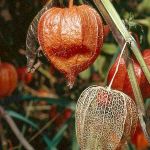| Common Name: |
Bladder Cherry |
| Other Names: |
Chinese Lantern, Bladder Cherry |
| Botanical Name: |
Physalis alkekengi |
| Genus: |
Physalis |
| Family: |
Solanaceae |
| Native Location: |
C and S Europe, and from W Asia to Japan. |
| Cultivation: |
Well-drained soil in sun or light shade. |
| Propagation: |
By seed sown in spring; by division in spring. |
| Harvest: |
Fruits are harvested when ripe and used fresh; as juice, or dried. For medicinal use, the calyx is removed. Leaves are picked in summer and used fresh as a poultice. |
| Height: |
60-75cm (24-30in) |
| Width: |
90cm (36in) or more. |
| Hardiness: |
Z3-9 |
| Parts Used: |
Fruits, Fruit juice. |
| Properties: |
A bitter-sweet, diuretic, laxative herb that lowers fever and reduces inflammation. |
| Medicinal Uses: |
Internally for intermittent fevers, urinary disorders, kidney and bladder stones, arthritis, rheumatism, and gout. Leaves formerly used externally for skin inflammations. Used in homeopathy for arthritic, rheumatic, and urinary disorders, and jaundice. |
| Warning: |
Foliage and unripe fruits are harmful if eaten. |
| Bibliography: |
Encylopedia of Herbs by Deni Brown Copyright ©: 1995, 2001 Dorling Kindersley Limited pps. 313-314
|

